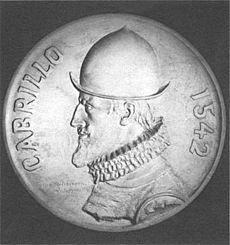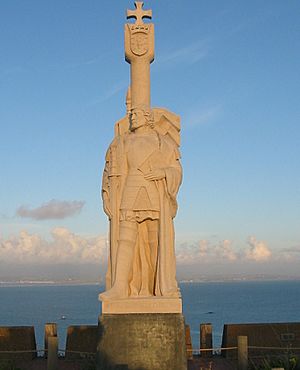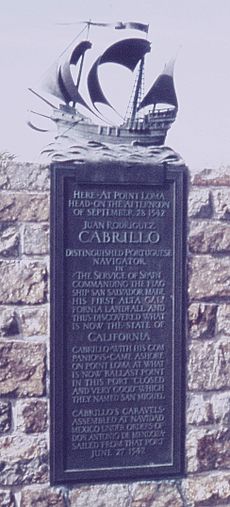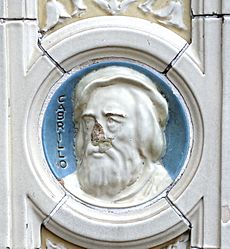Juan Rodríguez Cabrillo facts for kids
Quick facts for kids
Juan Rodríguez Cabrillo
João Rodrigues Cabrilho |
|
|---|---|
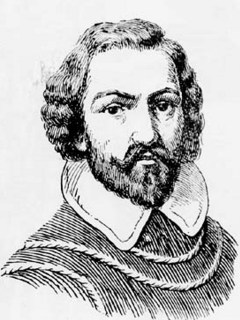
A picture of Cabrillo, painted after his death.
|
|
| Born | c. 1499 |
| Died | January 3, 1543 (aged 43–44) |
| Known for | First European in California |
Juan Rodríguez Cabrillo (also known as Portuguese: João Rodrigues Cabrilho; born around 1499 – died January 3, 1543) was an explorer from the Iberian Peninsula (modern-day Spain and Portugal). He is most famous for exploring the West Coast of North America for the Spanish Empire. He was the first European to explore what is now California, sailing along its coast in 1542–1543.
Contents
Who Was Juan Cabrillo?
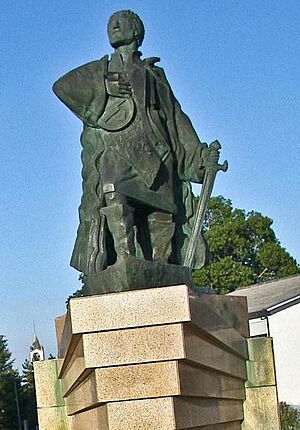
For a long time, people have debated if Cabrillo was Portuguese or Spanish. A Spanish writer named Antonio de Herrera y Tordesillas said Cabrillo was Portuguese. He wrote this 60 years after Cabrillo died. Many places in Portugal claim to be his birthplace.
However, in 2015, some documents were found that suggest Cabrillo might have been Spanish. A witness in a 1532 lawsuit, also named Juan Rodriguez Cabrillo, said under oath that he was born in Palma de Micergilio, a town in Spain. Other details about this witness match what we know about the explorer. Even with this new information, some people, especially in the Portuguese community, want more study to be sure.
In Portugal, a place called Lapela is said to be where his family's nickname "Cabrilha" came from. This later became the surname Cabrilho. There's even an old house in Lapela that locals call the "House of the Galician" or "House of the American," where they believe he was born.
Cabrillo's Journeys
When he was young, Cabrillo sailed to Havana. He later joined Hernán Cortés in Mexico (then called New Spain). Cabrillo became very rich from mining gold in Guatemala. He had children with an indigenous woman and later married Beatriz Sanchez de Ortega in Spain. She came back to Guatemala with him, and they had two sons.
Cabrillo was involved in the encomienda system. This system forced Native American people to work. For example, in Honduras, he separated families. He sent men to work in gold mines or to cut wood for shipbuilding. Women and girls were also forced to work for his soldiers and sailors.
In 1539, another explorer named Francisco de Ulloa discovered the Gulf of California. After this, the new ruler of New Spain, Antonio de Mendoza, asked Cabrillo to lead an expedition. Cabrillo's mission was to explore the Pacific coast to find new trade routes, possibly to China, or to find a mythical shortcut called the Northwest Passage. Cabrillo owned the main ship of his fleet and hoped to gain wealth from any trade or treasures found.
In 1540, Cabrillo's fleet sailed from Acajutla, El Salvador, and reached Navidad, Mexico, on Christmas Day. While there, another leader, Pedro de Alvarado, died in battle. The viceroy then took control of Alvarado's ships. Some ships went to the Philippines, and two ships were given to Cabrillo to sail north.
On June 27, 1542, Cabrillo began his famous journey from Navidad with three ships: the large flagship San Salvador, the smaller La Victoria, and the San Miguel. By August 1, they were near Cedros Island. Later that month, they sailed into unknown waters, where no Spanish ships had been before.
On September 28, Cabrillo landed in what is now San Diego Bay and named it "San Miguel." A week later, on October 7, he reached Santa Catalina Island, which he named "San Salvador." When a boat went to the island, many armed Native Americans appeared, but the explorers later became friends with them. The nearby San Clemente Island was named "Victoria." The next day, October 8, Cabrillo reached San Pedro Bay, calling it "Baya de los Fumos" (Smoke Bay). They anchored in Santa Monica Bay the following day. As they went up the coast, Cabrillo saw Anacapa Island, learning from the Native Americans that it was empty.
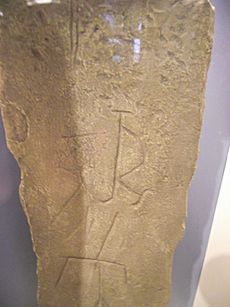
The fleet spent the next week around the islands, mostly at Cuyler Harbor on San Miguel Island. On October 18, they saw Point Conception, which they named "Cabo de Galera." Cabrillo's expedition recorded the names of many Chumash villages along the California coast in October 1542.
On November 13, they saw and named "Cabo de Piños" (possibly Point Pinos or Point Reyes). They missed the entrance to San Francisco Bay, probably because it is often covered in fog. The expedition might have sailed as far north as the Russian River or even the Columbia River before autumn storms forced them to turn back. On their way back down the coast, Cabrillo entered Monterey Bay, naming it "Bahia de Los Piños."
On November 23, 1542, the fleet returned to "San Salvador" (Santa Catalina Island) to spend the winter and fix their ships. Around Christmas Eve, Cabrillo was injured when he stumbled on a jagged rock while trying to help his men during an attack by Tongva warriors. The injury became infected, and he died on January 3, 1543. He was buried there. A possible headstone was later found on San Miguel Island. His second-in-command led the rest of the group back to Navidad, arriving on April 14, 1543.
The official report of Cabrillo's expedition was lost. All that remains is a summary made by another explorer, Andrés de Urdaneta, who also saw the ships' logs and maps. The first printed story of Cabrillo's journey didn't appear until the early 1600s.
Remembering Cabrillo
Cabrillo's discoveries were not widely known at the time, so none of the names he gave to places stuck. However, today Cabrillo is remembered as the first European to explore the California coast. Many parks, schools, buildings, and streets in California are named after him.
One important place is the Cabrillo National Monument, run by the National Park Service. It overlooks the bay and ocean from Point Loma in San Diego. It celebrates his first landing in California and offers great views. The monument has a large statue of Cabrillo, given by the government of Portugal, and a plaque from the Portuguese ambassador. A museum in the park teaches visitors about Cabrillo and his voyages. Every September, the Cabrillo Festival is held, a three-day event celebrating his discovery of San Diego Bay, including a re-enactment of his landing.
Another monument to Cabrillo is on San Miguel Island. In California, September 28 is officially "Cabrillo Day." There is also a group of Portuguese-Americans, mainly in California, called the Cabrillo Club.
In northern California, the Point Cabrillo Light (a lighthouse) is named after him. San Pedro, a part of Los Angeles, has Cabrillo Beach and the Cabrillo Marine Aquarium.
Schools named for him include Cabrillo College in Aptos, California, high schools in Lompoc and Long Beach, and several middle and elementary schools.
The part of California State Route 1 that goes from Las Cruces to San Francisco is called the Cabrillo Highway. The Cabrillo Bridge and Cabrillo Freeway (California State Route 163) in San Diego's Balboa Park are also named for him. Many cities in California have streets named after him.
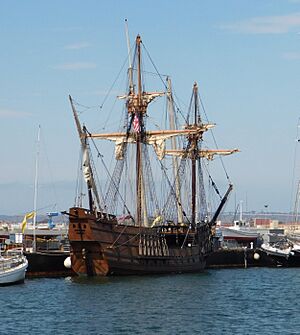
The SS Cabrillo was a wooden steamship launched in 1914. It was used as a ferry to Santa Catalina Island. During World War II, the United States Army used it to transport troops in northern California.
In 1992, the United States Postal Service released a stamp to honor Cabrillo.
The San Salvador Replica
The Maritime Museum of San Diego, working with Cabrillo National Monument, has built a full-sized, working, and historically accurate copy of Juan Rodriguez Cabrillo's flagship, the San Salvador. The replica was built based on research into how Spanish and Portuguese ships were made long ago.
The ship was built in public view on the shores of San Diego Bay. Professional boat builders and many volunteers worked on it. Its main beam was laid in April 2011. The ship was first shown to the public in September 2015, when it led a parade of tall ships. This replica ship now sails regularly along the Southern California coast. It is used as an educational tool to teach people about history.
See also
 In Spanish: Juan Rodríguez Cabrillo para niños
In Spanish: Juan Rodríguez Cabrillo para niños


